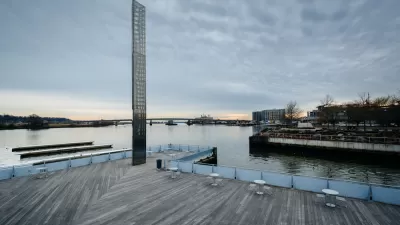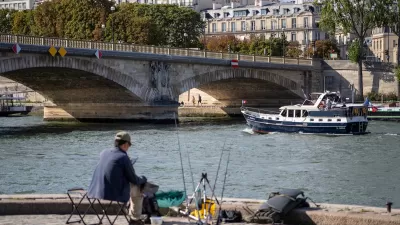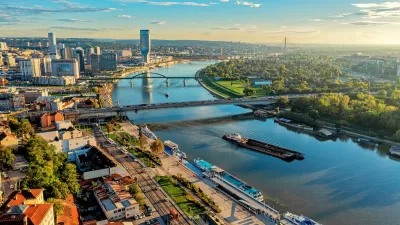An interview with organizers of the inaugural Swimmable Cities Summit, which took place this June 22-24 in Rotterdam, NL.
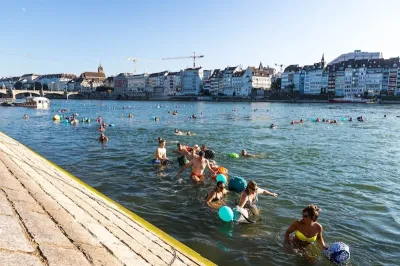
This piece was originally published on Mark Tirpak's Substack.
Is your city or town swimmable? Many urban areas are located along coasts, lakes and rivers, where swimming in clean and safe open waters can (potentially) be a delightful and useful public practice. Urban swimming can provide a refuge from urban heat. It can also promote exercise, relaxation and social connections while supporting a vital life skill. Additionally, urban swimming can encourage efforts to preserve and enhance ecosystems, while also attracting visitors and new residents to different places.
Urban open water swimming has deep historical roots—Benjamin Franklin, for example, was an avid swimmer, dipping into ponds in Boston as a kid and later enjoying the River Thames in London as a visitor. But would Franklin swim in Boston or London today? I am thrilled to learn about a growing movement of individuals, institutions and initiatives working to advance the idea of swimmable cities globally. I recently had the chance to pose questions to some of the organizers of the inaugural Swimmable Cities (SC) Summit—which took place June 22–24 in Rotterdam, NL and was open to the public. Here are their collective responses (edited):
What inspired the upcoming inaugural Swimmable Cities Summit? Why was Rotterdam chosen as the location?
Swimmable Cities (SC) was launched in the spring of 2024, ahead of the Paris Olympics and the City of Paris’s historic announcement to reopen the River Seine for swimming, after a 100-year prohibition. The SC steering group is composed of individuals representing different local and national urban swimming initiatives from around the globe, and we are united by the conviction that we need a structured movement that allows for networking and sharing knowledge and strategy in order to accelerate our efforts to make cities swimmable again. The City of Rotterdam offered us support in hosting the first Summit this June—which is a wonderful opportunity, with the event taking place near Rotterdam’s new urban swimming area in the harbor of Rijnhaven.
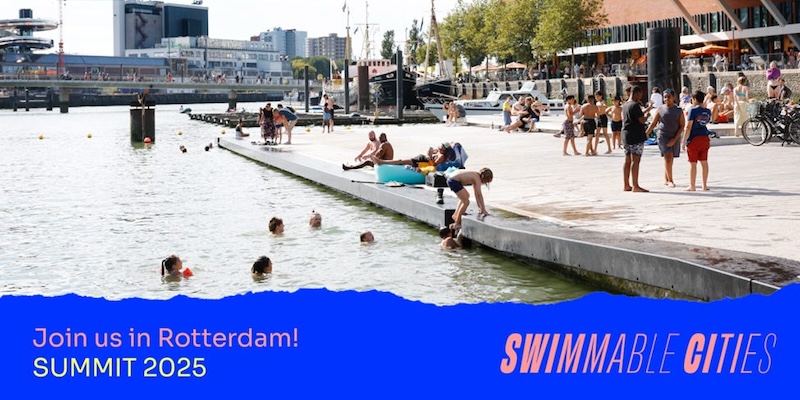
What do you think defines a "swimmable city"? When you think of swimmable cities, what examples come to mind?
Although most cities worldwide have been built along rivers, ports and coasts (barring a few exceptions), often access to the water for swimming is restricted or forbidden in urban areas—especially from the urban center. Moreover, some historic urban swimming facilities, including those from the 19th century, have been closed or even dismantled in some cities. In Switzerland, cities such as Zurich, Bern and Basel have maintained historic river baths, keeping alive the heritage of swimmable cities, and even inspiring recent projects (such as Flussbad Berlin). Urban swimmability includes care for water quality and accessibility with minimum infrastructures—as well as policies that support swimming as a legitimate activity along with other usages, such as shipping. The Swimmable Cities Charter and Principles explain some of these and related ideas in greater detail, and we encourage more people and cities to join the swimmable cities movement by signing the Charter via the SC website.
What do you think are some of the biggest obstacles that cities face in becoming more swimmable? Are there regional differences that you notice?
The main challenges seem to be comparable across regions, although there can be regional, cultural or regulatory differences between places. One common challenge can be political will; it can take time and effort to convince local political leaders to integrate urban swimming into their programs—however, more and more municipalities and governments seem to be keen to be part of the swimmable cities movement, as demonstrated with SC’s growing list of signatories. As major urban swimming projects and infrastructure can often take years to realize and they require ongoing maintenance, there is the risk that certain projects or initiatives lose political support with different administrations or majorities. There can also be political backlash (as we’ve observed in Berlin and Brussels recently). This is part of why citizen’s associations are crucial for the swimmable cities movement.
User conflicts can also be another obstacle. Municipalities and governments have to make place for swimming as an equal water activity (with major societal, health, touristic and other benefits), alongside uses such as shipping and industry. Moreover, good water quality for swimming purposes is a fundamental condition of our movement. Making cities and communities more swimmable can initiate greater care for and attention to water quality, and projects can lead to a surprising range of public improvements.
What would you like to see happen in the next 5–10 years as part of or in response to the swimmable cities movement?
We would like to see more urban swimming projects realized, but this will require a rethinking of the rules around access to urban waterways, better water quality monitoring and better education around access to urban water. The impressive example of the City of Paris, which will open three public swimming spots along the River Seine in July is a positive start. London is working on improving the city’s rivers and New York City is supporting a +Pool (floating pool in the East River) proposal.
[Baltimore, Maryland is also working to make its downtown harbor swimmable, and other examples globally abound!]
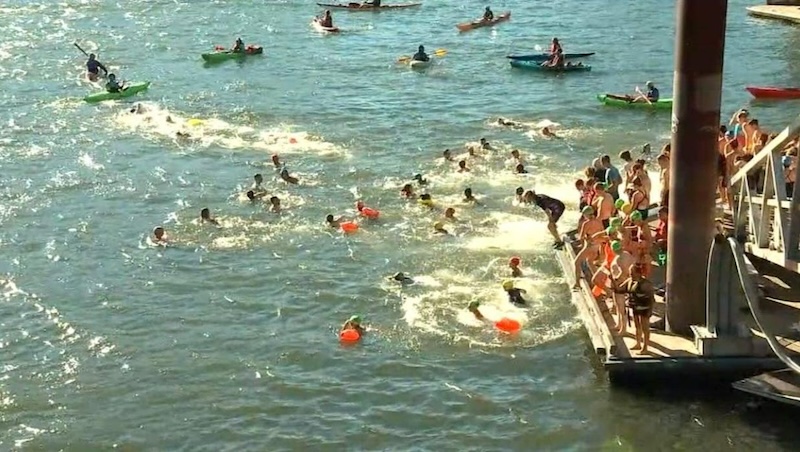
Could you talk more about swimmable cities in relation to climate change concerns or urban efforts?
Making cities swimmable can be a powerful response to climate change, including in relation to the threat of urban heat. Swimming has public health benefits, both physical and mental. It is also important to remember that, around the world, the majority of city dwellers aren’t able to simply take summer vacations to escape urban heat, so urban swimmability can be incredibly important for public health and wellbeing.
Moreover, the swimmable cities movement can lead to a fundamental reconsideration of the role and function of urban waterways—advancing a more human/nature-centered approach rather than the purely utilitarian concerns of transport or wastewater removal that can typically determine the management of urban waterways. Urban swimming can help raise awareness of a range of environmental concerns and perspectives.
What's shaped your commitments to swimmable cities?
[Sibylle van der Walt, on behalf of SC]: For myself and as a newly arrived German citizen in Metz, France during the very hot summers of 2017 and 2018, I found it very surprising that there were no official swimming spots on the River Moselle—and all the indoor pools were overcrowded by the demand! With some friends, I founded Metz Ville d’Eau in 2019 to help make the ponds and rivers of Metz more accessible to swimming. Fortunately, the municipality opened a public beach along the Moselle in 2023; it attracts families with children and non-swimmers, which aligns with our aims. However, we propose a more architecturally ambitious project to support athletic outdoor swimming in this section of Metz. We envision the creation of a natural swimming pool and facilities in the terminal basin of the Canal de Jouy, and comparable with the old Metz-Plage that closed in 1983.
What do you think might be some key gaps in research in regards to swimmable cities? What research questions related to swimmable cities, if any, are you most excited about?
A great prospect for swimmable cities is the potential for innovative water quality research aided by new digital tools that could allow for more effective regulation and management of different waterways. Chemical pollution is a major challenge that still needs to be tackled, and current regulations mostly consider biological pollution. We’re keen to see cities adopt nature based solutions to urban run-off, something that will take time and be complex in larger cities. Research will be a key part of Swimmable Cities after this year’s summit in Rotterdam. We have some of the world’s finest educators and researchers contributing to our network.
Are there any similar or related efforts that the swimmable cities movement draws inspiration from or tries to benchmark against?
The swimmable cities movement has a lot in common with the urban cycling movement—which strives to make leaders understand that city centers and roads need to accommodate cycling and allow for shared spaces and infrastructure between cars, pedestrians and cyclists, for the benefit of all city inhabitants. Urban swimmability can be viewed similarly, and making cities and communities more swimmable requires political will and attention.
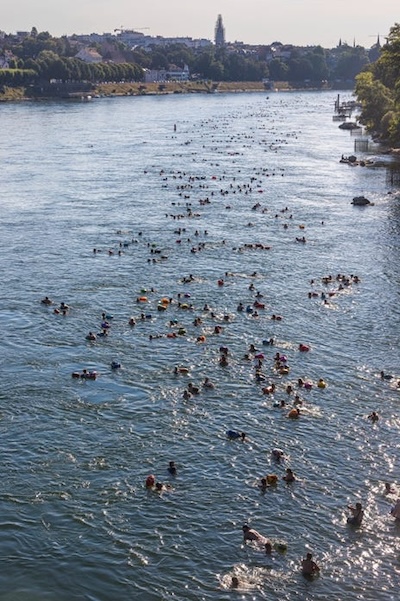
What could urban planners do to support swimmable cities?
They can visit places such as Copenhagen [or Washington, DC] or Zurich [or Rotterdam, etc.] during the summer months—to be inspired by the reality of new urban swimming opportunities and facilities that could be introduced in more places. Also, they could attend the Swimmable Cities Summit in Rotterdam or online events that run throughout the year. We would encourage them all to get in touch with us and help build this alliance.
How about college students or younger adults?
For students and young professionals, urban swimming associations such as Flussbad Berlin or Schwimmverein Donaukanal in Vienna can offer great ways to get engaged in cross-disciplinary projects involving architecture, ecology, city planning, sports, marketing etc. Moreover, young adults often take the lead in projects—so, go for it! We’ve also joined a number of universities working with students on access to water. We’re available across the world to bring our expertise to students.
In 2040, what do you hope to be celebrating in regards to swimmable cities?
As much as there is hope for more infrastructure and policies supportive of urban swimming by 2040, we must also do much more to tackle climate change, and this includes reducing and compensating for our carbon emissions. Re-naturalizing waterways and wetlands will help, and improving urban swimmability is part of this vision. Our cities will be hot places, the cost of building and operating traditional swimming pools will only increase, so lets open up the biggest spaces in our cities, the untouched blue spaces.
If people have questions or want to get more involved with Swimmable Cities, who should they contact?
Depending on their region or for general inquiries, feel free to contact SC via the details listed at swimmablecities.org—as well as to engage with the swimmable cities movement via social media (Instagram and LinkedIn). And there’s still time to register for our inaugural Summit in June!
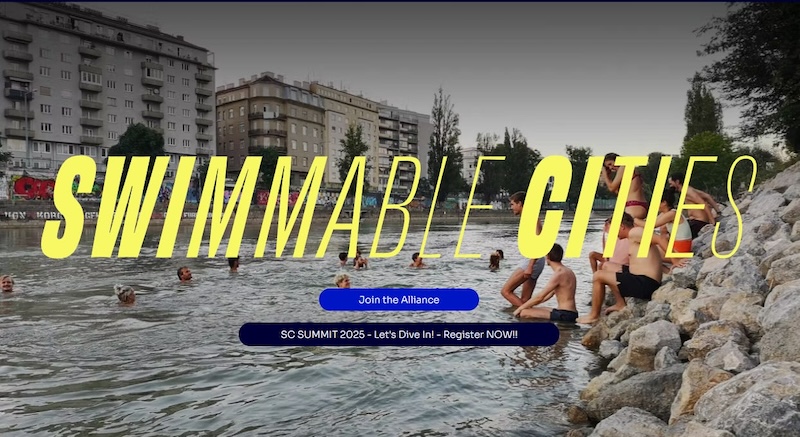
Matt Sykes is co-founder and convener of Swimmable Cities (SC) and founder and chief regeneration officer at Regeneration Projects in Australia.
Sibylle van der Walt is a member of the steering committee for Sustainable Cities (SC) and présidente of Metz Ville d’Eau in France.
Tim Edler is a member of the steering committee for Sustainable Cities (SC) and a founder, planner and strategist of Flussbad Berlin eV in Germany.
Chris Romer-Lee is co-founder of Swimmable Cities (SC) and Future Lidos. He’s also author of award winning bestseller Sea Pools (Batsford, 2023) and co-founder and former director of Studio Octopi.
Mark Tirpak is an adjunct / affiliate faculty member of Virginia Tech’s School of Public and International Affairs, as well as a guest instructor assisting Prof. Tom Sanchez at Texas A&M, College of Architecture. Mark also serves as a member of the American Planning Association’s Trend Scouting Foresight Community.

Planetizen Federal Action Tracker
A weekly monitor of how Trump’s orders and actions are impacting planners and planning in America.

Map: Where Senate Republicans Want to Sell Your Public Lands
For public land advocates, the Senate Republicans’ proposal to sell millions of acres of public land in the West is “the biggest fight of their careers.”

Restaurant Patios Were a Pandemic Win — Why Were They so Hard to Keep?
Social distancing requirements and changes in travel patterns prompted cities to pilot new uses for street and sidewalk space. Then it got complicated.

Albuquerque Route 66 Motels Become Affordable Housing
A $4 million city fund is incentivizing developers to breathe new life into derelict midcentury motels.

DC Area County Eliminates Bus Fares
Montgomery County joins a growing trend of making transit free.

Platform Pilsner: Vancouver Transit Agency Releases... a Beer?
TransLink will receive a portion of every sale of the four-pack.
Urban Design for Planners 1: Software Tools
This six-course series explores essential urban design concepts using open source software and equips planners with the tools they need to participate fully in the urban design process.
Planning for Universal Design
Learn the tools for implementing Universal Design in planning regulations.
Heyer Gruel & Associates PA
JM Goldson LLC
Custer County Colorado
City of Camden Redevelopment Agency
City of Astoria
Transportation Research & Education Center (TREC) at Portland State University
Camden Redevelopment Agency
City of Claremont
Municipality of Princeton (NJ)


























